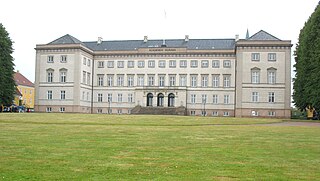Contents
| |||||
| Decades: | |||||
|---|---|---|---|---|---|
| See also: | Other events of 1639 List of years in Denmark | ||||
Events from the year 1639 in Denmark .
| |||||
| Decades: | |||||
|---|---|---|---|---|---|
| See also: | Other events of 1639 List of years in Denmark | ||||
Events from the year 1639 in Denmark .

Sorø Academy is a boarding school and gymnasium located in the small town of Sorø, Denmark. It traces its history back to the 12th century when Bishop Absalon founded a monastery at the site, which was confiscated by the Crown after the Reformation, and ever since, on and off, it has served as an educational institution, in a variety of forms, including as a knight academy founded by Christian IV and a venue for higher learning during the Danish Golden Age. Danish writer and academian Ludvig Holberg bequested most of his fortune to re-establishing the academy in 1750 after a devastating fire.
Kirsten Madsdatter was King Christian IV of Denmark's lover, and the mother of one of his three acknowledged, illegitimate sons, Christian Ulrik Gyldenløve.
Jens Munk was a Danish-Norwegian navigator and explorer. He entered into the service of King Christian IV of Denmark-Norway and is most noted for his attempts to find the Northwest Passage.

Dina Vinhofvers was a Danish silk worker who became famous because of her involvement in an alleged conspiracy of Danish statesman Corfitz Ulfeldt (1606–1664) against King Frederick III of Denmark in 1650–51.
Sophie Amalie Lindenov, Baroness of Lindenborg was a Danish noblewoman and landowner. She was Baroness of Lindenborg and the owner of Lindenborg Castle.

Reinhold Timm was a Danish painter. From 1619 he participated in the decoration in the Long Hall at Rosenborg Castle in Copenhagen with 7 or 8 large allegorical paintings of which only one, Unge mænd brydes på en bro, is signed while the others are attributed. Today they are kept at Kronborg Castle.
Events from the year 1802 in Denmark.
Events from the year 1845 in Denmark.
Events from the year 1870 in Denmark.
Events from the year 1775 in Denmark.

Ulrik Adolf Holstein, Greve til Holsteinborg was a Danish nobleman and statesman.
Events from the year 1624 in Denmark.

Gammel Estrup Manor is a red-brick Renaissance manor house some 20 km (12 mi) east of Randers in Jutland, Denmark. The manor as we know it today can be traced back to 1490. But excavations have revealed evidence of earlier constructions also mentioned in texts under the name Essendrup dating back to 1340.
Events from the 1580s in Denmark.
Events from the 1590s in Denmark.
Events from the year 1619 in Denmark.
Events from the year 1640 in Denmark.
Events from the year 1631 in Denmark.
Events from the year 1602 in Denmark.
Events from the year 1699 in Denmark.